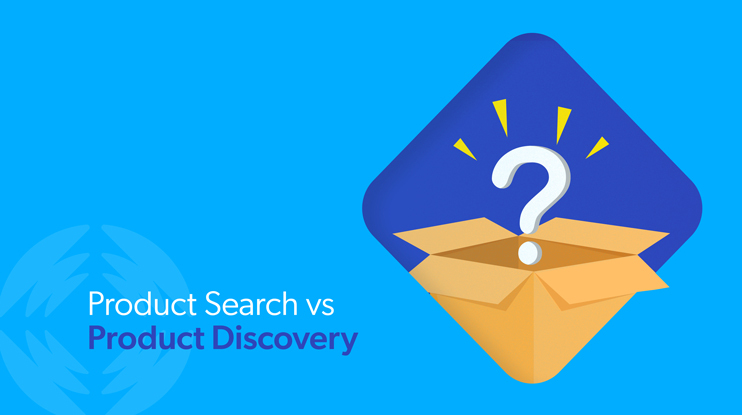The distinction between product search vs product discovery is subtle but highly lucrative. Here’s what to consider.
What’s the difference between ecommerce product discovery vs product search? The distinction between the two and how to best implement them on your website can be confusing. After all, both technology and customer expectations around ecommerce personalization are changing rapidly.
In a nutshell, product search is the act of looking for something specific using text-based search. Product discovery, on the other hand, uses prompts or recommendations to help shoppers find items they might want but aren’t specifically searching for. To allow a shopper to find what they want and more, you need an AI search engine. Let’s go over it all.
What Is Site Search?
When shoppers want to find specific items or products, they will use your site’s search for text-based search. That little search box can have a huge impact on your sales. More than three-quarters of shoppers say they typically use the search box on retail websites. And nine out of 10 say it’s super important to them that a retailer’s site’s search function works well.
Consumers don’t have a lot of patience with retail search experiences that don’t meet their expectations. Not being able to find what they’re looking for is the No. 1 reason consumers leave an online store without buying anything. According to Nielsen Norman, between 17-20% of users give up after just one failed query. Shoppers assume that if a site search returns a “no results” message, it means either the online store does not carry the item or the website is broken.
All of those abandoned shopping trips take a toll. Problems with search cost U.S. retailers an estimated $330 billion in 2021.
So what does a website’s search functionality need to do to satisfy shoppers? Most of us would probably say we just want to find what we’re looking for. Simple, right? Well, not exactly …
- A well-functioning search box should be able to figure out what a consumer wants even if there’s a typo or another error in the search term they enter. For example, if a visitor to a fashion retailer’s online store types in “Mark Jakobs,” the site should understand that they actually mean “Marc Jacobs” and be able to pull the right product category.
- Site search should feel personalized. For a logged-in customer, that could mean using their past purchases to provide better type-ahead suggestions.
- Even if a site visitor isn’t logged in, the search experience should add elements of personalization. For example, if a customer already has items in their cart, the site should be able to use that information to return better results for that customer’s subsequent searches.
- To return the most relevant search results, a website needs to be able to understand the customer’s intent. For example, if the seller provides informational content, that should show up in search results in addition to, and perhaps even ahead of, products. So a site should be able to discern that a consumer who searches for “how to clip dog’s nails” has a different intention than someone who searches “nail clippers for dogs.”
- For B2B sellers, the search box has to work even harder, thanks to product restrictions. There are a number of B2B ecommerce challenges: Different customers may have access to different products, and at different prices. And the search function should reflect that.
Site search needs to help the shopper who knows what they want but maybe isn’t exactly sure what it is called (or spelled). And in that case, Dynamic Navigation can come to the rescue by offering auto-suggest, type-ahead, dynamic facets, and filtering.
What Is Product Discovery?
Of course, shoppers don’t always know exactly what they want – or maybe they have already found what they wanted – and continue browsing. When a customer discovers a product that fits their needs or preferences that they weren’t looking for at first–that’s product discovery. And it happens all the time (but not by chance). Think about your own online shopping experiences:
- Maybe you’ve ended up purchasing a different item than the one you had planned to buy because it better suited your needs.
- Or perhaps you searched for an item and then the site helped you realize that you need additional items to complement it.
- And then there are the times you’re simply browsing your favorite retail site during a lull in your workday. You see a new product from a brand you love promoted on the home page, which inspires you to make a purchase.
- Sometimes you may even treat yourself to an impulse item because a site tells you that people who bought the products already in your cart also liked that item – which is called social proof.
- Or you may figure that as long as you’re on the site, you should also pick up items for an upcoming holiday or other seasonal activities the site reminds you of.
To drive this kind of ecommerce product discovery and unplanned purchases for your customers, your website needs an artificial intelligence and machine learning-driven recommender system plus dynamic navigation that shapes the entire customer journey. Dynamic navigation — the use of filters and facets to narrow search — is core to helping searchers find the right product, and it can also save a sale by helping shoppers find something else if what they were looking for wasn’t quite right.
Having both ai-powered recommendations and smarter search with dynamic navigation can deliver powerful payoffs.
The Power of a Recommender System
According to McKinsey, recommendations drive 35% of purchases on Amazon and 75% of choices on Netflix. Furthermore, over 60% of shoppers said they had purchased something based on a product recommendation from an online store. For ages 18-24, that number rises to 63%. And for ages 25-44, it’s 68%.
Recommendations can take a variety of forms:
- An online store can recommend products based on what a shopper has bought or browsed before. Consumers love this. More than 90% of shoppers said a personalized recommendation based on their previous shopping habits would motivate them to buy again from a site. For example, a site’s home page might greet you with an invitation to keep shopping in a category you were browsing on your last visit, or a reminder that you might be running low on items you previously purchased.
- Relevant product recommendations can also be based on your behavior during a particular shopping session, even if you’ve never visited that site before. For example, if you put an item in your cart, a site could show you items that are frequently purchased along with your selected item.
- Even generalized recommendations, such as products tied to an upcoming holiday or best-sellers and trending items can also help enhance the product discovery experience.
- Product recommendations can even be part of the search experience. A familiar example of this is a search results page that shows you not just the product you searched for, but also other, similar products.
The biggest challenge with recommendations is simply making sure the recommended products are relevant to the shopper. While consumers appreciate recommendations based on their past shopping behaviors, that can be difficult or impossible. Our research has found that 70 to 95% of users visit a website less than twice a year and most aren’t logged in.
And even when an online store has information about what a customer has bought in the past, it can still have trouble determining intention. The site has to be smart enough to understand that if a shopper buys a new dresser, she probably doesn’t want to see more recommendations for dressers similar to that one. Instead, it would be more helpful to see recommendations for other bedroom items that would complement the new dresser.
Unlock Relevant Recommendations for New Shoppers
With new AI innovation, cold-start shoppers can experience more personalization than ever increasing customer satisfaction.
For example, product embeddings capture affinities between products. This is done by representing each product as a numeric vector, so products in similar contexts have similar vectors. Products are mapped to vectors in such a way that items that customers perceive or use in similar ways are clustered together.
Machine learning algorithms are based on product vector mappings combined with site behavior. After a few clicks on a site, elements such as query suggestions, product result rankings and recommendations become personalized in real-time for the user — even if they are new or anonymous.
How Machine Learning Helps Both The Product Discovery Process and Search
Thanks to advancements in AI, it’s now possible to implement unified solutions that power both search and discovery. Coveo offers a robust, easy-to-implement solution that combines:
- search engine core with UI tools
- machine learning models ready to personalized search results and offer recommendations
- user analytics in a fully managed offering with the service and support you need to be successful.
Here are some of the Coveo platform’s best capabilities when it comes to search and discovery.
Smarter Search
Automatic Relevance Tuning learns what search users seek and delivers it. To identify customer preferences, Coveo captures signals derived from online customer behavior in the form of events from each website interaction. This includes what a person types (or retypes) in a query term, what they eventually click or don’t click, what leads to a conversion, and data such as the location they log in from and the time of day/year.
With type-ahead and query suggestions in the search box, shoppers can get where they need to go faster. Visual product previews cued off of their search further reduce friction. Dynamic faceting adds another layer of utility to search. Customers can filter by price, availability, BOPIS (buy online, pick up in store) and product attributes like size or type. Dynamic navigation can modify an incoming query to fine-tune the ordering of facets and facet values.
… even for B2B Sellers and Manufacturers
But ecommerce retailers are not the only ones who can benefit from enhanced product search. B2B sellers can combine products, attributes, and availability constraints at the time of search. Indexing capability automatically respects product restrictions or entitlements, price lists, and currency for each account group setup in CRM or ERP applications. This means customers search and see only the products, bundles, or kits and related pricing available to them.
Search can also return results from both structured and unstructured data sources. For example, a search for “mountain bike upgrades” could return relevant products as well as content like manuals or how-to videos, in a single relevant search results list.
This kind of AI search capability offers an enhanced customer experience to help increase customer loyalty.
Ready to Leverage AI to Drive Ecommerce Sales?
All of this is only an overview of how Coveo’s AI search for finding and discovery can help boost sales on your site.
Have questions or want to get a unique walkthrough as to how AI can transform your online store? Book a demo today.
Dig Deeper
Learn how FleetPride, the largest distributor of aftermarket heavy-duty truck and trailer parts in the U.S., partnered with Coveo for AI ecommerce search.
With Coveo’s artificial intelligence technology solutions and a better understanding of their customers, FleetPride was able to boost customer engagement, deflect customer cases, and create more sales opportunities through customized shopper experiences.


